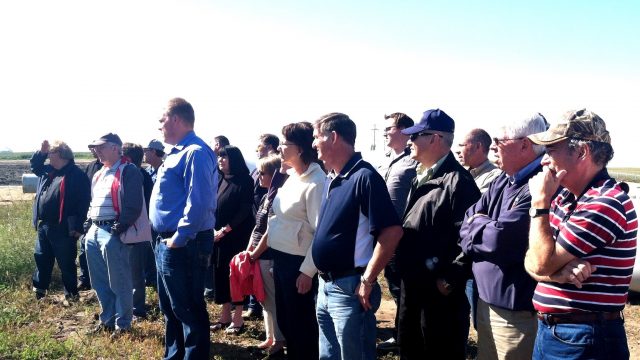Rep. Rick Holman: Oil Boom Brings Lasting Benefits For North Dakota

Forty North Dakota legislators spent two days touring the oil production area in Western North Dakota.
As I looked up at the top of a drilling rig near Watford City on a beautiful summer morning, I could not help but think of the person who would be working 120 feet up in a January blizzard. Our variable weather in this mid-continent region can be shock for someone who comes to North Dakota from elsewhere for the opportunity to make a good living. Looking around, I saw four men standing off to the side, likely in their 30’s or 40’s, and left the main group for an opportunity to visit with someone who works on the rig. These four men came to North Dakota from different parts of the US; Oklahoma, Louisiana, Colorado and Wyoming. They all had children; three had their families back in their home state while the one from Louisiana had just purchased a home in Dickinson. When asked, why here? One commented, “Where else could I make a year’s wages, working only half the year?” That refers to the work plan that has him putting in long hours with overtime, so he could travel back home during his week or so off. Two of the three flew home on breaks while the ones from Dickenson and Wyoming drive.
Drilling rigs run 24 hours a day until the well is completed; it is not shut down. A thirty person crew working shifts keeps it going. This particular company has drilling time down to an average of 18 days followed by three days to move to a new site. Additionally, horizontal directional drilling allows them to drill several wells on the same site so sometimes the move is only feet instead of miles.
Following our visit to the source of the oil we spent some time examining what happens after the oil comes out of the ground. There is still too much flaring but efforts are being made to increase the capture the natural gas. Currently, much of this resource is being wasted by burning it off but a new 1.2 billion dollar gas plant near Watford City will help alleviate some of the problem. Coming on line in December, a new refinery under construction at Dickinson will start producing diesel eliminating some of the need to move oil out of state for processing. Most of the diesel will be used in the immediate area. We still have a long way to go, but progress is being made to better use all the product from each well. It’s important to note that many of the workers in the West are not working directly with oil production but with the many areas of construction needed to support the industry. As an example, I was informed that there were 650 construction workers building the refinery.
A major part of the tour had us visit and listen to city leaders from Dickinson, Williston and Watford City as well as county officials from the surrounding counties. Since I live near Mayville, Portland and Hillsboro my frame of reference is that of a small town. Hence, seeing what is happening to Watford City was a real eye-opener. Imagine if the geographic footprint of your town doubled or tripled in just a few years. Imagine if the school population increased by 50 percent or more. Imagine if the traffic on the roads doubled or tripled with trucks outnumbering cars by a wide margin. Imagine if the population of your county doubled or tripled in just a few years. How can you develop the water, sewer, roads, streets, schools, housing, law enforcement, emergency services and all the other things that require long-range planning, building and financing?
Yes, we did see some of the problems that come from the huge increase in population but I was also impressed by the local leadership that we witnessed. Volunteer as well as paid leaders doing their best and taking the time to use evidence based planning as they try to envision where their city or county will be in five or ten years.
I’ll close with an example of how things can change. Because of the hundreds (thousands?) of workers, housing is a high priority. Tuesday night, after listening to Watford City leaders, our bus pulled up to a nearly new facility with individual rooms for 500 workers. That’s nearly half the former population of Watford City. After being cleared by security, our fifty member group entered a two story, structure; each of us assigned to a clean, 8 x 12 dormitory type room. After good night’s sleep and a great breakfast in the large dining room we loaded the bus and moved on for a tour of this rapidly changing community.
We observed many challenges and successes due to the rapid oil development, but with visionary leadership at the local level, cooperation and respect between those directly benefiting and those not, and support from local and state government, I believe that all North Dakotan’s can have lasting benefits from this dramatic change.




